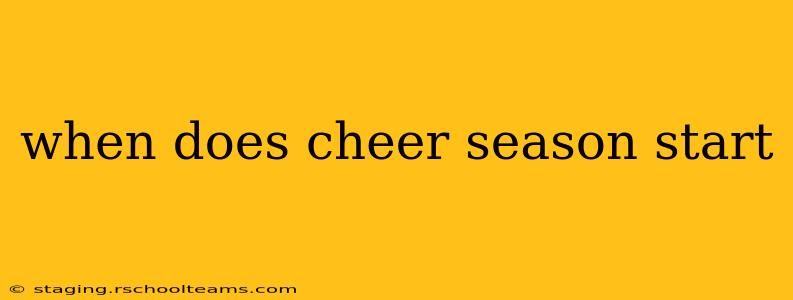Cheerleading, a sport demanding incredible athleticism, dedication, and teamwork, has a season that varies depending on several factors. There's no single start date that applies universally. This guide will break down the key elements that influence when cheer season begins, helping you understand the complexities involved.
What Factors Determine the Start of Cheer Season?
Several factors influence when a cheer season starts:
-
Level of Competition: Youth recreational leagues often start earlier in the fall, sometimes as early as August. High school and collegiate programs typically begin their seasons in late summer or early fall, aligning with the academic calendar. All-star cheerleading, known for its intense training and competition schedule, often kicks off in the spring or summer for the upcoming competitive season.
-
Geographical Location: Climates and school systems vary across the country and globally. Warmer climates might start practices earlier, while colder areas might delay the start until after the summer heat subsides. School districts also influence the start dates, aligning them with their academic calendars.
-
Specific Team/Organization: Each team or organization sets its own schedule. This is affected by factors like coach availability, gym access, and the team's competitive goals. Some teams prioritize a longer pre-season for extensive training, while others may opt for a shorter lead-up to competition.
-
Type of Cheerleading: The style of cheerleading also influences the timing. For example, sideline cheerleaders' seasons are typically tied to their school's sports seasons, while competitive cheer teams have separate training and competition schedules.
When Do Different Levels of Cheerleading Typically Start?
Let's break down some common cheerleading categories and their typical season starts:
Youth Recreational Cheerleading
- Start Date: Often begins in late August or early September.
- Season Length: Usually shorter than other levels, lasting until late fall or early winter.
High School Cheerleading
- Start Date: Typically starts in late August or early September, coinciding with the beginning of the school year.
- Season Length: Extends throughout the fall and winter, with competitions and performances scheduled alongside the school's sports seasons.
Collegiate Cheerleading
- Start Date: Similar to high school, usually beginning in late August or early September, often slightly later, dependent on the college's academic schedule.
- Season Length: The season extends throughout the fall and winter, focusing on game-day performances and potential competitive events.
All-Star Cheerleading
- Start Date: This is often the most variable. Many All-Star teams begin their practices as early as Spring or Summer for intensive training and preparation for a long and demanding competition season.
- Season Length: This is the longest season; it stretches from spring/summer practice all the way into winter and spring, peaking with major competitions.
How Can I Find My Local Cheer Team's Start Date?
The best way to find a specific team's start date is to:
- Check the team's website or social media pages: Most teams will announce their start date on their official platforms.
- Contact the team's coach or director: Reach out directly to get the most accurate and up-to-date information.
- Inquire with your local recreation center or school: If you are interested in joining a youth or school-based team, contact the relevant organization.
What if I'm New to Cheerleading and Want to Join?
If you're interested in cheerleading, contacting local teams or gyms is the best approach. They'll provide information on tryout dates, practice schedules, and fees. Many teams offer introductory classes or open practices to help newcomers learn the basics.
In conclusion, the start of cheer season isn't a single date but rather a range that depends on multiple factors. By understanding these factors and utilizing the resources mentioned, you can determine when the cheer season begins for you or your child. Remember to always check with your specific team or organization for the most accurate information.
